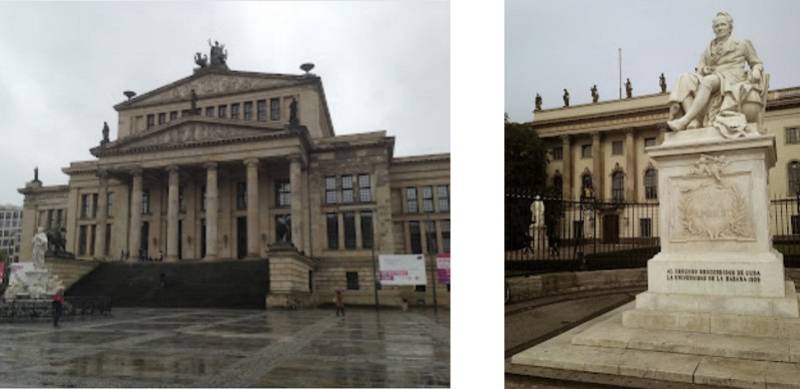
This trip had been long in the making. My interest in Germany began when I was in high school and intensified during my days at the University of Karachi. Germans had made many contributions in economics, literature, philosophy and science. And then there was Hitler.
I had taken a one-year course in German at the Goethe Institut in Karachi, thinking I would go there for graduate studies.
Before the trip, I read In the Garden of Beasts. It’s set in Berlin in the early 1930s, when Hitler was appointed Chancellor. I also saw the film Downfall, which provides a gripping portrait of Hitler’s last days in the bunker.
When we boarded a taxi at the Berlin airport, I felt that my tryst with history had begun. For 55 years, the city was the capital of East Germany during the Cold War. For 12 prior years, it was the capital of the Third Reich. We also planned to visit Potsdam where Frederick the Great lies buried. Prussia had the reputation of being an army with a state and not the other way around – an expression that is also used to describe Pakistan.
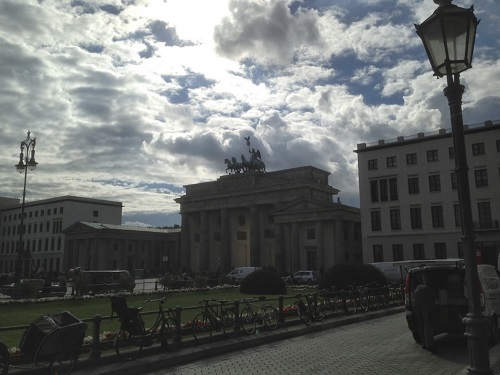 Our first day began with a 15-minute walk toward the Brandenburg Gate. More than any other object, this gate symbolises Berlin. When we spotted it, it was framed by clouds that seemed to be breaking out in an overture.
Our first day began with a 15-minute walk toward the Brandenburg Gate. More than any other object, this gate symbolises Berlin. When we spotted it, it was framed by clouds that seemed to be breaking out in an overture.
The gate is patterned after an entrance at the Acropolis in Athens. The Quadriga at the top of the Gate had been taken by Napoleon to Paris as a trophy after his conquest of Berlin in 1806, which followed his celebrated victory at Jena. After his defeat in 1815 at Waterloo, the victorious Germans led by Field Marshal von Blucher brought it back to Berlin.
Nearby was the Reichstag, the seat of parliament. The edifice was architecturally imposing. The glass dome at the top, the work of world-renowned British architect Norman Foster, gave it a modern look. Getting in was not easy. You needed to book your place in advance. A native German had advised me that the best way to get in was to book a meal at the restaurant at the top. Our plan was to return the following day for breakfast. We started to walk back to the hotel and stopped at a restaurant along the way to grab an afternoon meal. It turned out to be a Russian restaurant called Moscow-Berlin. It was the first sign of the Russian presence in Berlin and sent a chill down my spine. We would see many more signs of the Russian presence in the days to come.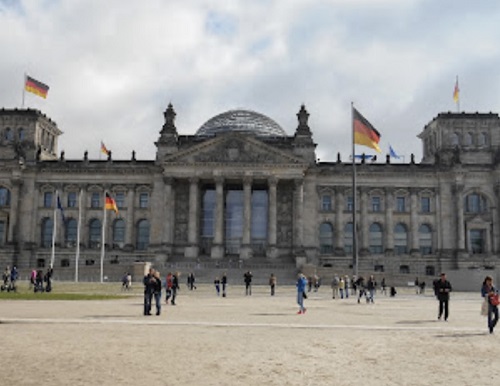
The next day we headed to the museum island by doing the two mile walk along the Spree River (we also did a cruise on the river a few days later and were able see the major buildings in the heart of the city). The island was the setting for absolutely top-notch museums and art galleries. Along the way was the very impressive Jewish Museum, multiple stories tall, featuring a modern design and shimmering with sunlight that was bouncing off its glass-and-metal exterior.
The Pergamon Museum was the highlight of the day. The displays are very nicely presented and the artwork is truly awesome. The entire altar from the ancient Greek town of Pergamon (now in Turkey) is housed there as is the imposing gate of Ishtar from Babylon. And there are numerous artifacts from the Greek and Assyrian civilisations. Some cannot be found in any other museum in the world. That fact alone makes Berlin a city worth visiting.
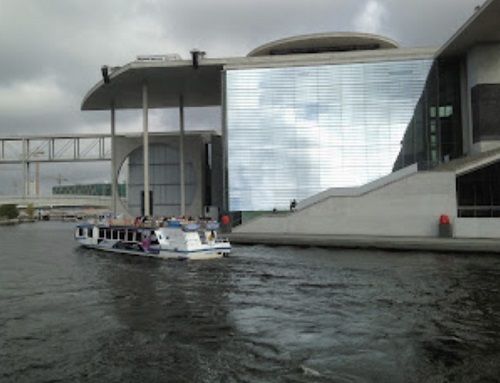 Suitably enriched with the history of the ancient world, we emerged from the museum only to find that a hard rain was threatening to soak us from head to toe. We decided to get into a plastic-covered bike taxi.
Suitably enriched with the history of the ancient world, we emerged from the museum only to find that a hard rain was threatening to soak us from head to toe. We decided to get into a plastic-covered bike taxi.
The driver was a Berlin native married to an Englishwoman. We went through the cradle of Berlin, which was a nice cluster of shops and restaurants around the old St. Nikolai church, past the very large square which used to be the site of the Palace of the Prussians until it was torn down by the East Germans so it could be used for the May Day parade in an imitation of the ceremonies in Red Square in Moscow, through the GendarmenMarkt Plaza, with its two churches and culture house, possibly the finest square in town, and on to the area where Checkpoint Charlie was located once the Berlin Wall had been built in 1961.
The guide observed that many of the Prussian monuments that had been destroyed by the East Germans were now being rebuilt to rematch the originals. So that led to the inevitable question: Would a memorial ever be built for Hitler? He said: “No.” Then, to erase even the trace of a doubt from my mind, he looked back at me and added in perfect, unaccented English: “It is unthinkable.”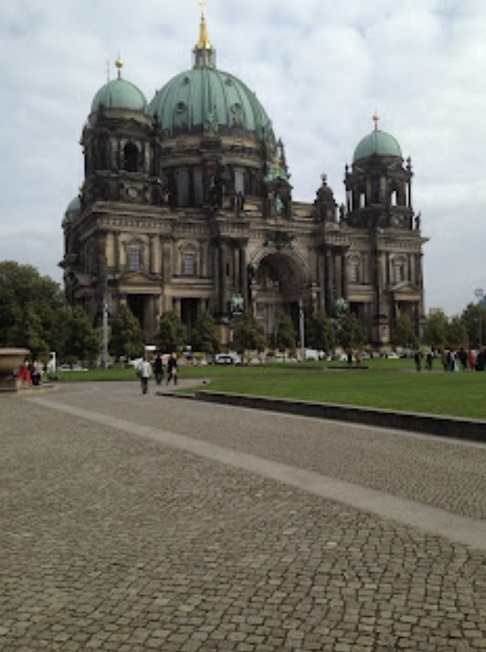
To cool off, I asked him if he had seen Downfall and, to my surprise, he said no. He had heard many good things about it and confirmed that the actor who played Hitler is outstanding.
The next day came the tour of the New Museum which contains the incredibly rich Egyptian Museum. All the museums on the island are a treat to behold, even from the outside, but this one truly is the jewel. The original bust of the Egyptian queen Nefertiti is the grand treasure in this museum but there are numerous other objects that capture your attention: mummies, mummy cases and statues, some housed in caves and caverns which evoke the experience of being entombed, and large paintings that transport you to Luxor.
Surprisingly, most of the objects are not housed in cases and you get a distinct sense of being in ancient Egypt as you look at them. You are allowed to photograph all the objects but not the bust of the queen, which sits in a large room all by itself.
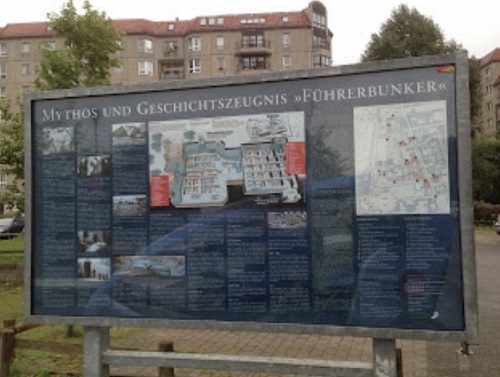 The Dom cathedral is located nearby. It is an architectural masterpiece. The crypt houses the remains of Prussian royalty including several of the Kaisers. The crowns placed at the head of some of the graves single out the monarchs of a bygone era.
The Dom cathedral is located nearby. It is an architectural masterpiece. The crypt houses the remains of Prussian royalty including several of the Kaisers. The crowns placed at the head of some of the graves single out the monarchs of a bygone era.
There is not much left to see of Hitler’s Bunker which is buried under a parking lot. Very little of the Nazi architecture has survived in Berlin. A building that housed the aviation ministry and included the offices of Field Marshal Goering, the head of the Luftwaffe, still stands. It is now the home of another ministry. The buildings which housed the headquarters of the Gestapo and the SS also stand nearby and have been repurposed.
There is not much that is left of Checkpoint Charlie, which came into being when the Wall was put up in 1961, other than some touristy stands and a few random remnants of the Wall. Around town, you can see sections of the Wall, some covered with German graffiti and some smothered with modern art.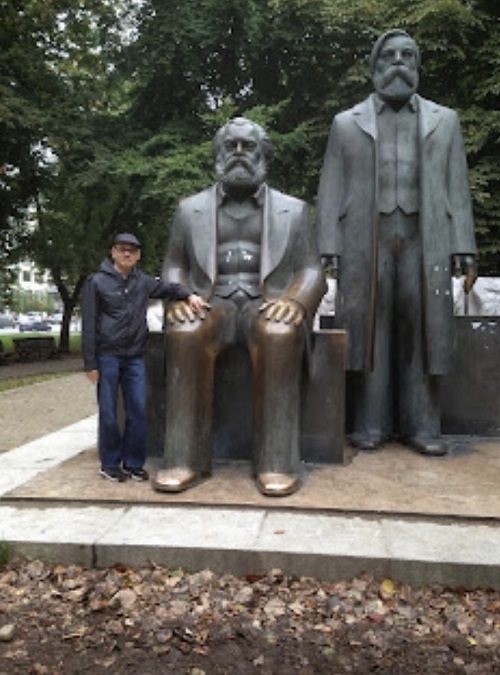
Unsurprisingly, Berlin also has a Marx Avenue. It was once called Socialist Avenue and prior to that, Stalin Avenue. It runs through an area that is noticeable for the monotonous, soul-stultifying architecture associated with the Soviet dictator. Elsewhere there is a giant statue of Marx and Engels standing side by side.
There is also a statue of Comrade Lenin at the entrance to the capacious Museum of German History whose collections go back to the time when the Celts inhabited the area.
Nearby is the storied Humboldt University. Albert Einstein taught there, Marx was a student and Lenin spent time there. Others included Heisenberg (of the uncertainty principle) and Plank (of the constant). And the philosophers Hegel (of dialectical materialism) and Schopenhauer. Over the years, it has produced more than two dozen Nobel Laureates including Wassily Leontief in Economics.
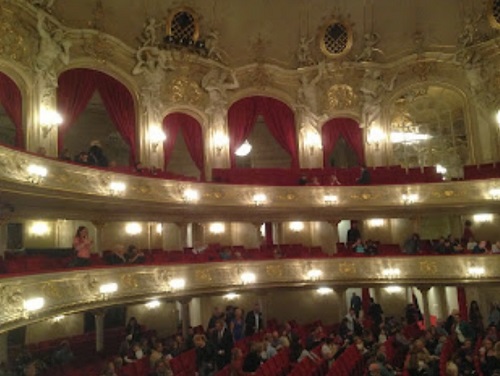 A giant statue of Frederick the Great on a horse was located not too far. It is across the street from the Bebelplaz where the National Opera, a Catholic church, and the former Royal Library (now the School of Law of Humboldt University) are located.
A giant statue of Frederick the Great on a horse was located not too far. It is across the street from the Bebelplaz where the National Opera, a Catholic church, and the former Royal Library (now the School of Law of Humboldt University) are located.
Berlin is famous for its operas, plays and musical performances and most of them are sold out for weeks in advance. We were able to catch a ballet about “Oz – The Wonderful Wizard” at the Komische Oper (Comic Opera). It was a humorous adaptation of the American classic. The inside of the building, where the operas are staged, is elegant.
We also watched a performance by German Radio Culture at the annex to the world renowned Berlin Philharmonic.
On our last day we took a regional express train to Potsdam. It was just 45 minutes away. There are two palaces there: the Schloss Sanssouci and the Neues Palais. Between the two palaces is the expansive Park Sanssouci. Frederick the Great lies underneath a very simple slab in the Sanssouci (meaning carefree) Palace. He wanted to be remembered as a philosopher and not as a king and chose not to be buried with his family members at the Dom in Berlin.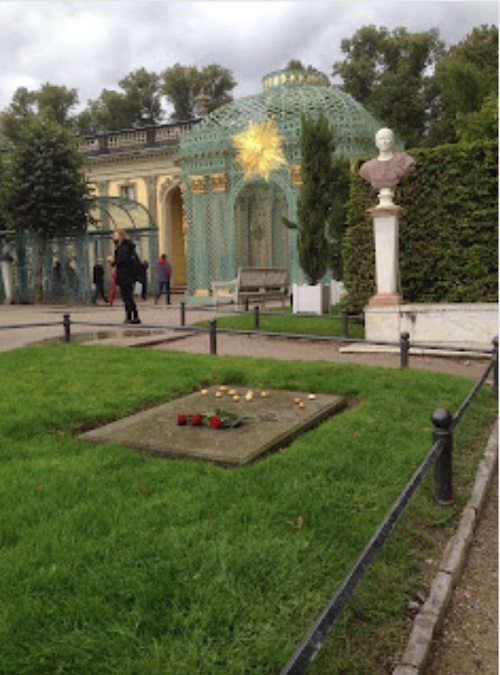
Also in town is the Einstein Gymnasium. The physicist spent a fair bit of time in Potsdam. Of course, Potsdam is also the city where the future of Berlin was decided by the Big Three at the conclusion of the Second World War. We saw the building (Schloss Cecilienhof) where it was signed. It seems to have been converted into a hotel. The guide pointed out the rooms in which Churchill, Stalin and Truman were housed. A few miles away is the facility where the KGB had a large and presumably top secret facility during the Soviet era. We were told that the current Russian president, Vladimir Putin, served there for many years.
To round off the day, we took a local train to the palace of Queen Sophie Charlotte (Schloss Charlottenberg). It is in Berlin. Booth the palace and its gardens are impressive and grand in their own way. We arrived at a time when the sun was about to set. It had lit up the art objects at the top of the palace and surrounding buildings.
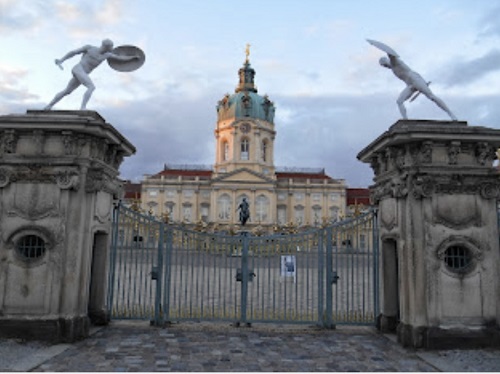 After seeing the palace, we took a cab to the hotel. The driver turned out to be Turkish and after he heard us talking in Urdu, he asked us if we spoke English! Switching to English, we told him we had a very pleasant time when we toured his native land back in 2005.
After seeing the palace, we took a cab to the hotel. The driver turned out to be Turkish and after he heard us talking in Urdu, he asked us if we spoke English! Switching to English, we told him we had a very pleasant time when we toured his native land back in 2005.
On another day, the cab driver had turned out to be an Iranian woman. As I started to speak with her, she said her English was not that good and showed me a book, I speak English, which she kept in the door compartment. So, I started speaking a few basic sentences in German with her and she switched to German. Now all her statements were in German. At some point I had to tell her to please switch back to English since my German was much more limited than her English. I also told her that I had a book at home called Ich Spreche Deutsch and she laughed. She had come to Germany after the fall of the Shah and her German was very fluent. As we parted, I said “Khuda Hafiz,” meaning “Goodbye” in Farsi, and a look of amazement appeared on her face.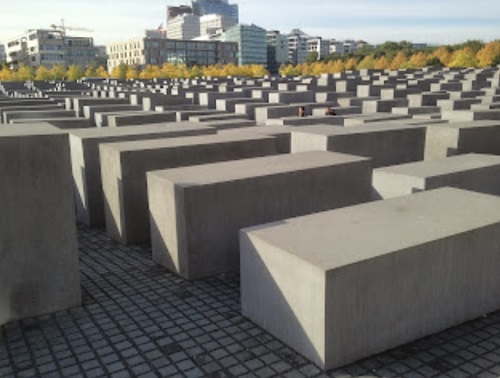
On our last day, we walked over to the Holocaust Museum, located just a few blocks away from Hitler’s bunker. It was mid-morning and the light was good. The museum occupies an area which is the size of several blocks. Through a minimalistic design, it evokes silently the tragic isolation, incarceration and murder of six million European Jews which took place on Hitler’s orders. There are rows and rows of concrete blocks of different sizes and heights with undulating walkways that run in-between them. It is the ultimate meditation on the human condition.
I had taken a one-year course in German at the Goethe Institut in Karachi, thinking I would go there for graduate studies.
Before the trip, I read In the Garden of Beasts. It’s set in Berlin in the early 1930s, when Hitler was appointed Chancellor. I also saw the film Downfall, which provides a gripping portrait of Hitler’s last days in the bunker.
When we boarded a taxi at the Berlin airport, I felt that my tryst with history had begun. For 55 years, the city was the capital of East Germany during the Cold War. For 12 prior years, it was the capital of the Third Reich. We also planned to visit Potsdam where Frederick the Great lies buried. Prussia had the reputation of being an army with a state and not the other way around – an expression that is also used to describe Pakistan.
 Our first day began with a 15-minute walk toward the Brandenburg Gate. More than any other object, this gate symbolises Berlin. When we spotted it, it was framed by clouds that seemed to be breaking out in an overture.
Our first day began with a 15-minute walk toward the Brandenburg Gate. More than any other object, this gate symbolises Berlin. When we spotted it, it was framed by clouds that seemed to be breaking out in an overture.The gate is patterned after an entrance at the Acropolis in Athens. The Quadriga at the top of the Gate had been taken by Napoleon to Paris as a trophy after his conquest of Berlin in 1806, which followed his celebrated victory at Jena. After his defeat in 1815 at Waterloo, the victorious Germans led by Field Marshal von Blucher brought it back to Berlin.
The guide pointed out the rooms in which Churchill, Stalin and Truman were housed. A few miles away is the facility where the KGB had a large and presumably top secret facility during the Soviet era. We were told that the current Russian president, Vladimir Putin, served there for many years
Nearby was the Reichstag, the seat of parliament. The edifice was architecturally imposing. The glass dome at the top, the work of world-renowned British architect Norman Foster, gave it a modern look. Getting in was not easy. You needed to book your place in advance. A native German had advised me that the best way to get in was to book a meal at the restaurant at the top. Our plan was to return the following day for breakfast. We started to walk back to the hotel and stopped at a restaurant along the way to grab an afternoon meal. It turned out to be a Russian restaurant called Moscow-Berlin. It was the first sign of the Russian presence in Berlin and sent a chill down my spine. We would see many more signs of the Russian presence in the days to come.

The next day we headed to the museum island by doing the two mile walk along the Spree River (we also did a cruise on the river a few days later and were able see the major buildings in the heart of the city). The island was the setting for absolutely top-notch museums and art galleries. Along the way was the very impressive Jewish Museum, multiple stories tall, featuring a modern design and shimmering with sunlight that was bouncing off its glass-and-metal exterior.
The Pergamon Museum was the highlight of the day. The displays are very nicely presented and the artwork is truly awesome. The entire altar from the ancient Greek town of Pergamon (now in Turkey) is housed there as is the imposing gate of Ishtar from Babylon. And there are numerous artifacts from the Greek and Assyrian civilisations. Some cannot be found in any other museum in the world. That fact alone makes Berlin a city worth visiting.
 Suitably enriched with the history of the ancient world, we emerged from the museum only to find that a hard rain was threatening to soak us from head to toe. We decided to get into a plastic-covered bike taxi.
Suitably enriched with the history of the ancient world, we emerged from the museum only to find that a hard rain was threatening to soak us from head to toe. We decided to get into a plastic-covered bike taxi.The driver was a Berlin native married to an Englishwoman. We went through the cradle of Berlin, which was a nice cluster of shops and restaurants around the old St. Nikolai church, past the very large square which used to be the site of the Palace of the Prussians until it was torn down by the East Germans so it could be used for the May Day parade in an imitation of the ceremonies in Red Square in Moscow, through the GendarmenMarkt Plaza, with its two churches and culture house, possibly the finest square in town, and on to the area where Checkpoint Charlie was located once the Berlin Wall had been built in 1961.
The guide observed that many of the Prussian monuments that had been destroyed by the East Germans were now being rebuilt to rematch the originals. So that led to the inevitable question: Would a memorial ever be built for Hitler? He said: “No.” Then, to erase even the trace of a doubt from my mind, he looked back at me and added in perfect, unaccented English: “It is unthinkable.”

To cool off, I asked him if he had seen Downfall and, to my surprise, he said no. He had heard many good things about it and confirmed that the actor who played Hitler is outstanding.
The next day came the tour of the New Museum which contains the incredibly rich Egyptian Museum. All the museums on the island are a treat to behold, even from the outside, but this one truly is the jewel. The original bust of the Egyptian queen Nefertiti is the grand treasure in this museum but there are numerous other objects that capture your attention: mummies, mummy cases and statues, some housed in caves and caverns which evoke the experience of being entombed, and large paintings that transport you to Luxor.
Surprisingly, most of the objects are not housed in cases and you get a distinct sense of being in ancient Egypt as you look at them. You are allowed to photograph all the objects but not the bust of the queen, which sits in a large room all by itself.
 The Dom cathedral is located nearby. It is an architectural masterpiece. The crypt houses the remains of Prussian royalty including several of the Kaisers. The crowns placed at the head of some of the graves single out the monarchs of a bygone era.
The Dom cathedral is located nearby. It is an architectural masterpiece. The crypt houses the remains of Prussian royalty including several of the Kaisers. The crowns placed at the head of some of the graves single out the monarchs of a bygone era.There is not much left to see of Hitler’s Bunker which is buried under a parking lot. Very little of the Nazi architecture has survived in Berlin. A building that housed the aviation ministry and included the offices of Field Marshal Goering, the head of the Luftwaffe, still stands. It is now the home of another ministry. The buildings which housed the headquarters of the Gestapo and the SS also stand nearby and have been repurposed.
There is not much that is left of Checkpoint Charlie, which came into being when the Wall was put up in 1961, other than some touristy stands and a few random remnants of the Wall. Around town, you can see sections of the Wall, some covered with German graffiti and some smothered with modern art.

Unsurprisingly, Berlin also has a Marx Avenue. It was once called Socialist Avenue and prior to that, Stalin Avenue. It runs through an area that is noticeable for the monotonous, soul-stultifying architecture associated with the Soviet dictator. Elsewhere there is a giant statue of Marx and Engels standing side by side.
There is also a statue of Comrade Lenin at the entrance to the capacious Museum of German History whose collections go back to the time when the Celts inhabited the area.
Nearby is the storied Humboldt University. Albert Einstein taught there, Marx was a student and Lenin spent time there. Others included Heisenberg (of the uncertainty principle) and Plank (of the constant). And the philosophers Hegel (of dialectical materialism) and Schopenhauer. Over the years, it has produced more than two dozen Nobel Laureates including Wassily Leontief in Economics.
 A giant statue of Frederick the Great on a horse was located not too far. It is across the street from the Bebelplaz where the National Opera, a Catholic church, and the former Royal Library (now the School of Law of Humboldt University) are located.
A giant statue of Frederick the Great on a horse was located not too far. It is across the street from the Bebelplaz where the National Opera, a Catholic church, and the former Royal Library (now the School of Law of Humboldt University) are located.Berlin is famous for its operas, plays and musical performances and most of them are sold out for weeks in advance. We were able to catch a ballet about “Oz – The Wonderful Wizard” at the Komische Oper (Comic Opera). It was a humorous adaptation of the American classic. The inside of the building, where the operas are staged, is elegant.
We also watched a performance by German Radio Culture at the annex to the world renowned Berlin Philharmonic.
On our last day we took a regional express train to Potsdam. It was just 45 minutes away. There are two palaces there: the Schloss Sanssouci and the Neues Palais. Between the two palaces is the expansive Park Sanssouci. Frederick the Great lies underneath a very simple slab in the Sanssouci (meaning carefree) Palace. He wanted to be remembered as a philosopher and not as a king and chose not to be buried with his family members at the Dom in Berlin.

Also in town is the Einstein Gymnasium. The physicist spent a fair bit of time in Potsdam. Of course, Potsdam is also the city where the future of Berlin was decided by the Big Three at the conclusion of the Second World War. We saw the building (Schloss Cecilienhof) where it was signed. It seems to have been converted into a hotel. The guide pointed out the rooms in which Churchill, Stalin and Truman were housed. A few miles away is the facility where the KGB had a large and presumably top secret facility during the Soviet era. We were told that the current Russian president, Vladimir Putin, served there for many years.
To round off the day, we took a local train to the palace of Queen Sophie Charlotte (Schloss Charlottenberg). It is in Berlin. Booth the palace and its gardens are impressive and grand in their own way. We arrived at a time when the sun was about to set. It had lit up the art objects at the top of the palace and surrounding buildings.
 After seeing the palace, we took a cab to the hotel. The driver turned out to be Turkish and after he heard us talking in Urdu, he asked us if we spoke English! Switching to English, we told him we had a very pleasant time when we toured his native land back in 2005.
After seeing the palace, we took a cab to the hotel. The driver turned out to be Turkish and after he heard us talking in Urdu, he asked us if we spoke English! Switching to English, we told him we had a very pleasant time when we toured his native land back in 2005.On another day, the cab driver had turned out to be an Iranian woman. As I started to speak with her, she said her English was not that good and showed me a book, I speak English, which she kept in the door compartment. So, I started speaking a few basic sentences in German with her and she switched to German. Now all her statements were in German. At some point I had to tell her to please switch back to English since my German was much more limited than her English. I also told her that I had a book at home called Ich Spreche Deutsch and she laughed. She had come to Germany after the fall of the Shah and her German was very fluent. As we parted, I said “Khuda Hafiz,” meaning “Goodbye” in Farsi, and a look of amazement appeared on her face.

On our last day, we walked over to the Holocaust Museum, located just a few blocks away from Hitler’s bunker. It was mid-morning and the light was good. The museum occupies an area which is the size of several blocks. Through a minimalistic design, it evokes silently the tragic isolation, incarceration and murder of six million European Jews which took place on Hitler’s orders. There are rows and rows of concrete blocks of different sizes and heights with undulating walkways that run in-between them. It is the ultimate meditation on the human condition.

